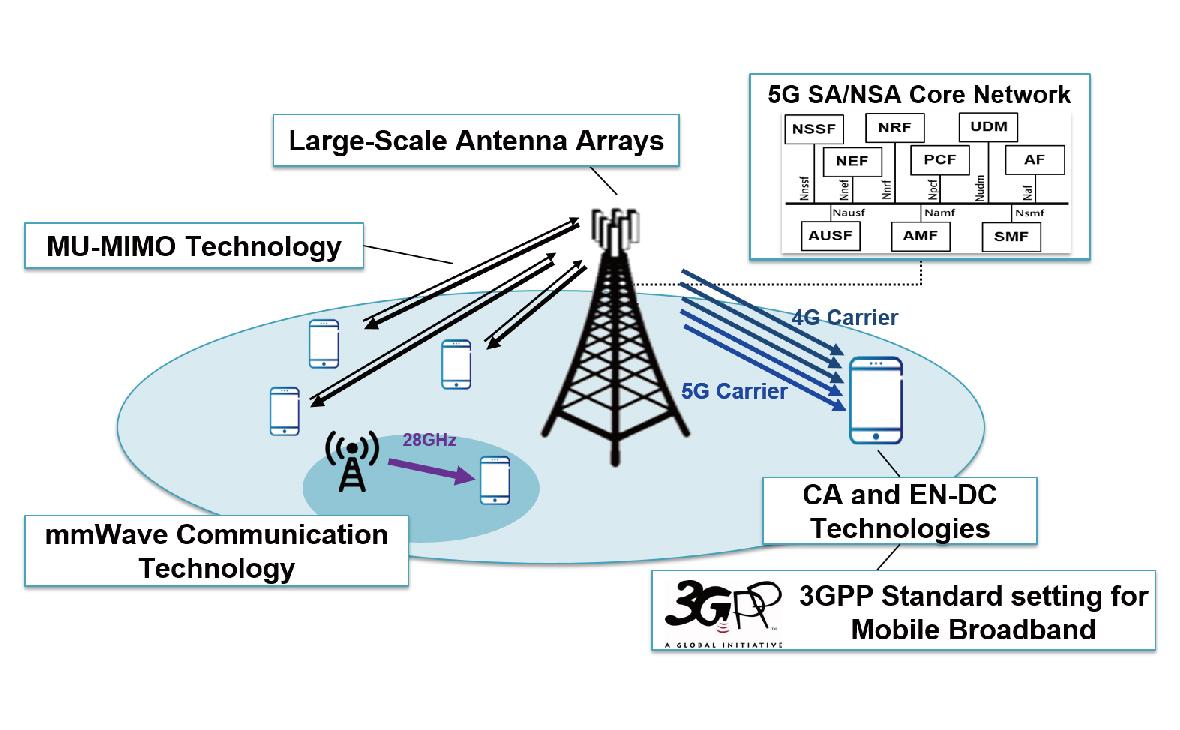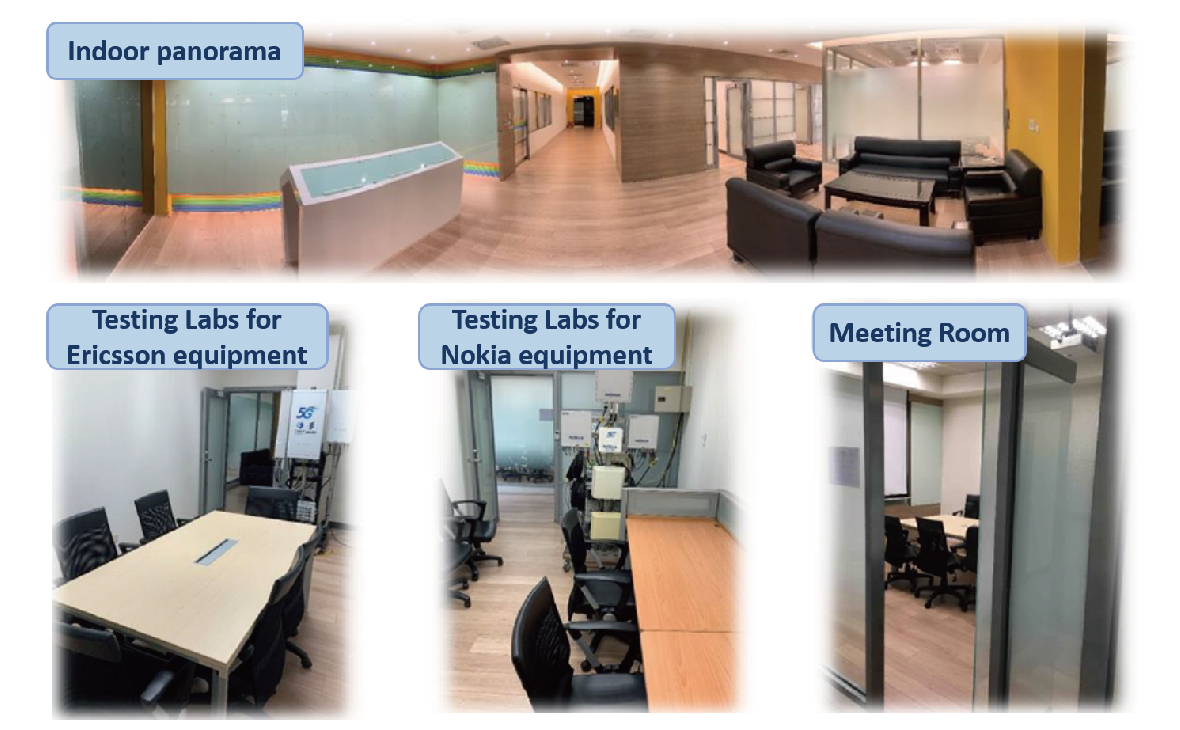5G/B5G NETWORK TECHNOLOGY
Overview
Taiwan has officially entered 5G era since CHT (Chunghwa Telecom) launched 5G services on June 30, 2020. With the development of 5G/B5G communication technologies, along with large bandwidth, low latency and wide area connections, the applications have become more flexible and diverse. The high-speed transmission and diverse applications of 5G networks also need to be realized by new technologies. 5G technologies includelarge-scale antenna arrays, CA/EN-DC (Carrier Aggregation/E-UTRAN New Radio-Dual Connectivity), mmWave (millimeter-wave) transmission, network slicing, network interoperability, and network virtualization/cloudification, etc. To track the latest technological development, CHTTL (CHT Telecommunication Laboratories) actively participates in the 3GPP (3rd Generation Partnership Project) standard organization and builds a complete 5G/B5G end-to-end experimental field. Through preliminary research, verification and analysis of new technologies, CHTTL provides strategies for 5G network evolution and solutions to related issues. It is expected to continue providing users with high-quality services and to create business opportunities for cross-domain integration.5G/B5G NETWORK TECHNOLOGY
CORE TECHNOLOGY
- 3GPP standard specification for mobile broadband
- Large-scale antenna arrays
- CA and EN-DC Technologies
- mmWave communication technology
- 5G SA/NSA core network

5G/B5G key technologies.

Real scenes of Open LAB for 5G/B5G trial and testing networks.
5G/B5G NETWORK TECHNOLOGY
Application Status
3GPP standard specification for mobile broadband :By participating 3GPP(3rd Generation Partnership Project) mobile network technology standard organization, CHTTL not only tracks the new technology trends and evolutions of mobile networks, but also leads some of the spectrum combination standard specifications of 3GPP 5G CA/EN-DC (Carrier Aggregation/E-UTRAN New Radio-Dual Connectivity). For example, the released spectrum combinations of 900MHz, 1800MHz, 2100MHz, 2600MHz, 3500MHz and 28GHz in Taiwan are mostly proposed by CHTTL. In this way, users can simultaneously utilize multiple 4G and 5G spectrum resources to transmit/receive data and enjoy ultra-high-speed transmission experience.
On the other hand, CHT is the leading company for part of the spectrum combination standard specifications. It is mainly responsible for managing the progress of the work items, which include research on harmonics and intermodulation distortion caused by terminal self-interference in carrier aggregation. CHT also submits related technical proposals at 3GPP meeting to complete the detailed standard specification.
On the other hand, CHT is the leading company for part of the spectrum combination standard specifications. It is mainly responsible for managing the progress of the work items, which include research on harmonics and intermodulation distortion caused by terminal self-interference in carrier aggregation. CHT also submits related technical proposals at 3GPP meeting to complete the detailed standard specification.
Large-scale antenna arrays:Compared with two to four antenna ports at 4G base stations, 5G base stations are equipped with hundreds of antenna elements for data transmission. Beamforming technology using large-scale array antennas can improve the transmission quality of users through accurate beamforming methods.
Additionally, the vertical-dimension signal can be added to the traditional horizontal dimension of the signal to further improve coverage in high-rise buildings or long and narrow streets. Besides, a massive number of antennas can make the realization of MU-MIMO (Multiple User-Multiple Input Multiple Output) technology more easily, which enables the base station to transmit data to multiple users with the same time-frequency resources, thereby increasing the capacity of the base station.
So far, CHTTL has completed related technical trials and testing of large-scale antenna array technology, including the coverage, capacity, MU-MIMO, etc. Taking the experiment of MU-MIMO technology as an example, it is found that the capacity of base stations can be increased by more than two times during the field trial. Thus, it is very suitable to be applied to high-load base station.
Additionally, the vertical-dimension signal can be added to the traditional horizontal dimension of the signal to further improve coverage in high-rise buildings or long and narrow streets. Besides, a massive number of antennas can make the realization of MU-MIMO (Multiple User-Multiple Input Multiple Output) technology more easily, which enables the base station to transmit data to multiple users with the same time-frequency resources, thereby increasing the capacity of the base station.
So far, CHTTL has completed related technical trials and testing of large-scale antenna array technology, including the coverage, capacity, MU-MIMO, etc. Taking the experiment of MU-MIMO technology as an example, it is found that the capacity of base stations can be increased by more than two times during the field trial. Thus, it is very suitable to be applied to high-load base station.
CA and EN-DC Technologies:Since the 4G era, CA technology has been widely used. It is the most effective way to increase the user's transmission rate. With CA technology, users can use multiple carriers to transmit data at the same time and enjoy ultra-high-speed transmission experience. In 5G, in addition to CA technology, dual-connectivity technology that aggregates the 4G and 5G spectrum resourcesis also utilized to further improve the transmission rate of users.
CHTTL has completed the EN-DC technology experiments of three carriers in LTE and a single carrier at 3.5GHz in NR. The peak rate can be increased by 60%, which is up to 2.14Gbps. In OpenSignal's November 2021 Global 5G Experience Report, Taiwan ranks the top three in the world. One of the main factors for this result is the adoption of carrier aggregation and EN-DC technologies.
CHTTL has completed the EN-DC technology experiments of three carriers in LTE and a single carrier at 3.5GHz in NR. The peak rate can be increased by 60%, which is up to 2.14Gbps. In OpenSignal's November 2021 Global 5G Experience Report, Taiwan ranks the top three in the world. One of the main factors for this result is the adoption of carrier aggregation and EN-DC technologies.
mmWave communication technology:Unlike traditional 2G/3G/4G mobile communication using sub-6GHz band, the spectrum of 5G system extends to the mmWave (millimeter-wave) band to provide ultra-high-speed transmission. At present, Taiwan has released the mmWave frequency band of 27.9~29.5GHz. However, due to ultra-high frequency of mmWave, the transmission signal attenuates rapidly. Therefore, the coverage area of mmWave is rather small.
Although mmWave has not been commercialized on a large scale, millimeter-wave technology is still expected. Due to its large bandwidth, ultra-high speed transmission capability can be provided by mmWave. For example, the downlink transmission rate measured by CHTTL can reach about 3Gbps under the mmWave bandwidth of 600MHz. To this end, it is expected that the mmWave technology will perform well in scenarios such as hotspots or indoor scenes with high-speed requirements, and meet the enterprise customer demand in the future.
Although mmWave has not been commercialized on a large scale, millimeter-wave technology is still expected. Due to its large bandwidth, ultra-high speed transmission capability can be provided by mmWave. For example, the downlink transmission rate measured by CHTTL can reach about 3Gbps under the mmWave bandwidth of 600MHz. To this end, it is expected that the mmWave technology will perform well in scenarios such as hotspots or indoor scenes with high-speed requirements, and meet the enterprise customer demand in the future.
5G SA/NSA core network: CHTTL has built a 5G/B5G trial network and introduced equipment from international Tier-1 manufacturers Ericsson and Nokia to validate key technologies, such as network slicing, SBA (Service-Based Architecture), SA/NSA (Standalone/Non-Standalone) network interoperability, control/user plane separation, and network virtualization/cloudification. Therefore, CHT’s network evolution strategies can be planned.
Furthermore, CHTTL also builds 5G/B5G Open LAB to provide a research and interoperability test environment for equipment and chip manufacturers. In terms of 5G/B5G vertical applications, CHTTL, equipment suppliers and various industries have cooperated with each other to demonstrate several 5G innovative application services, including the AR (Augmented Reality) tour in National Palace Museum and musicians/singers from different locations playing together in real time at KKBOX concert.
Furthermore, CHTTL also builds 5G/B5G Open LAB to provide a research and interoperability test environment for equipment and chip manufacturers. In terms of 5G/B5G vertical applications, CHTTL, equipment suppliers and various industries have cooperated with each other to demonstrate several 5G innovative application services, including the AR (Augmented Reality) tour in National Palace Museum and musicians/singers from different locations playing together in real time at KKBOX concert.

